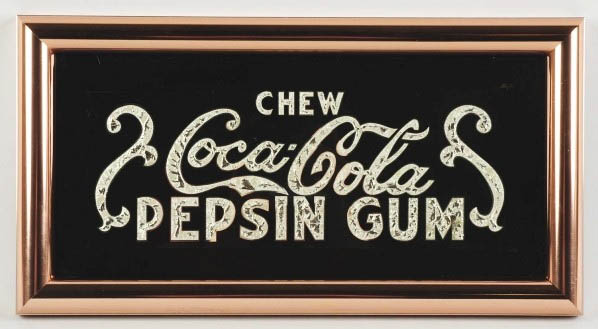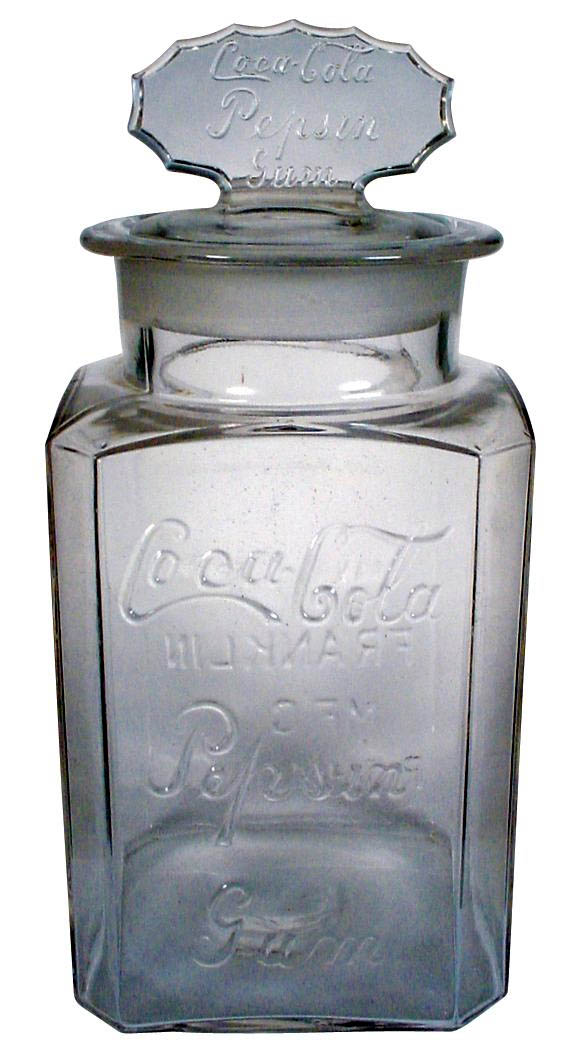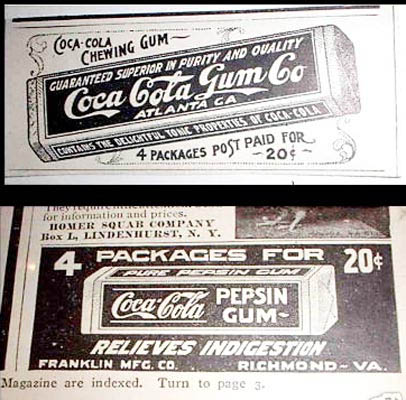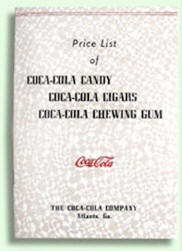Coca-Cola Gum
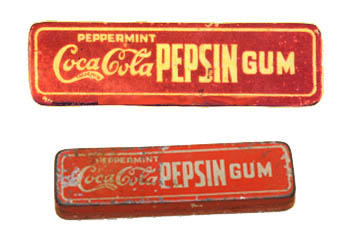 Coca-Cola
gum was made from 1903 to 1920. The gum was not made by the Coca-Cola
beverage company but by another Atlanta company, the Coca-Cola Gum Company,
which used both the Coca-Cola name and the logo. The Coca-Cola Gum Company
was bought by Franklin Manufacturing (later called Franklin-Caro Co.) and
moved to Richmond, Virginia, in the early 1900s. The beverage company did
not like this use of their trademark and bought out the gum company by 1924.
Coca-Cola Gum items are rare and usually bring high prices.
Coca-Cola
gum was made from 1903 to 1920. The gum was not made by the Coca-Cola
beverage company but by another Atlanta company, the Coca-Cola Gum Company,
which used both the Coca-Cola name and the logo. The Coca-Cola Gum Company
was bought by Franklin Manufacturing (later called Franklin-Caro Co.) and
moved to Richmond, Virginia, in the early 1900s. The beverage company did
not like this use of their trademark and bought out the gum company by 1924.
Coca-Cola Gum items are rare and usually bring high prices.
Coca-Cola allowed the use of its name and logo with a variety of non-soda items produced by outside manufacturers, such as candy and cigars. One such product was Coca-Cola chewing gum, a product that enjoyed some success in the early part of the 20th century. Eventually, though, Coca-Cola became more reticent about allowing the use of its trademarks with anything other than official company-sponsored products, especially when those products were of such low quality that they might reflect badly on Coca-Cola itself. Such was the case with Coca-Cola chewing gum, which by 1924 had so deteriorated in quality as to be an embarrassment to the company. Coca-Cola sought to remedy the situation by purchasing the nearly bankrupt chewing gum maker through an intermediary and quietly retiring the product.
Coca-Cola Building Annex
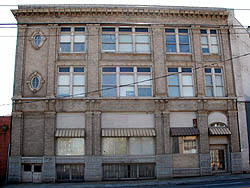 Built
in 1903 to house the newly formed Coca-Cola Chewing Gum Company, the
Coca-Cola Building Annex represents the early development of the Coca-Cola
Company and its attempts to diversify its line of products. Other products
included cigars and candies. Unlike their soft drink, the gum was not
successful and Coca-Cola dropped the product in 1905. The building was an
annex to the Dixie Coca-Cola Bottling Company Plant , Atlanta's Coca-Cola
bottling headquarters which contained office space and a highly automated
factory in the basement where the Coca-Cola syrup was produced.
Built
in 1903 to house the newly formed Coca-Cola Chewing Gum Company, the
Coca-Cola Building Annex represents the early development of the Coca-Cola
Company and its attempts to diversify its line of products. Other products
included cigars and candies. Unlike their soft drink, the gum was not
successful and Coca-Cola dropped the product in 1905. The building was an
annex to the Dixie Coca-Cola Bottling Company Plant , Atlanta's Coca-Cola
bottling headquarters which contained office space and a highly automated
factory in the basement where the Coca-Cola syrup was produced.
The three-story Classical Revival Annex
building extended the main building by five bays with its cornice heights,
building materials, fenestration and organization of the facade closely
matching the headquarters' exterior. The three-part main facade features a
rusticated basement level, a first floor with large plate-glass windows
framed by paired pilasters, and at the second and third levels, double and
tripartite windows grouped between pilasters. Classical Revival details
include terra cotta brackets and capitals, a modillion and dentil cornice,
and elliptical windows. Historic fabric that remains intact on the interior
of the building includes common bond perimeter brick walls, exposed floor
joists, wood sub floors, wood baseboards, and window surrounds.
Rehabilitations that took place from 1983 to 1984 and 1993 to 1994 have
subdivided the once large open interior spaces into many smalls rooms on
every level. A light well and skylight were also constructed on the east
side of the building. The present use of the Annex is for housing homeless
HIV-positive and AIDS patients that are receiving outpatient treatment at
nearby Grady Hospital , as well as administrative offices.
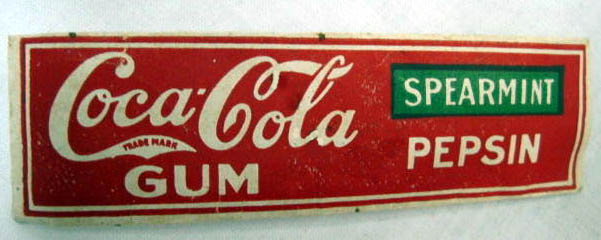 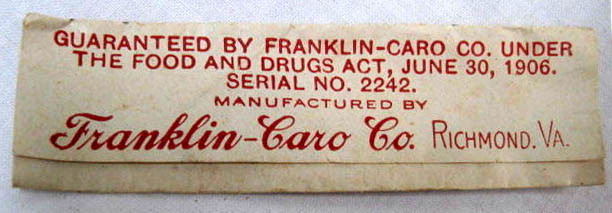 |
This is the front and back of a piece of Pepsin Gum. |
|
|
Framed in contemporary metal
frame, this heavy beveled glass sign was found in Chicago in the 1970s
or 1980s, between the walls of a building. According to the original
finder, the silver leaf and reverse paint was applied in the 1980s. Some
question has existed about the authenticity of this sign over the years.
|
|
|
This is a jar used to hold Coca-Cola Pepsin Gum circa 1916.This jar is 11" high 4 1/2" wide. The lid says Coca Cola, the front of the jar says Coca-Cola Pepsin Gum, the back says MANUFACTURED FRANKLIN MFG CO RICHMOND VA. |
|
|
Here is a rare glimpse of a couple Coca-Cola ads advertising the Coca-Cola Gum in 1904-1905. The cover and page from 1940
Coca-Cola catalog. The facing page advertises Coca-Cola chewing gum.
|
